As you may have noticed I think we can do more with Augmented Reality than simple data layers on top of the real world. The principles and technology of layering anything from anywhere make some things possible that can really help us.
An example of this concept is the considering the problem of driving along the motorway behind a massive great lorry of van. You keep your distance yet you have no real awareness of whats happening just in front.
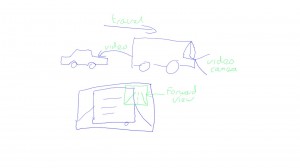
We have an augmented reality of a rear view mirror to give us situational awareness of what is behind.
So what would happen whilst in your car you could have an augmented reality forward view, of HUD that showed you what was in front of the obstruction using their view of the world? This is an augmented reality application but not a traditional one. It is a magic lens but it is real world to real world.
It is not without problems of course, how big, how much screen, but it can be based on peer to peer networking between the vehicles. It also has the benefit that when in a traffic jam there is not reason not to zoom you view forward hopping from car to car until you get to the problem in the road.
Monthly Archives: May 2011
The power of the prefab -unity3d
I have been diving into some more unity3d development for some mini games for a gaming startup. Once again the subtle power of Unity3d shone through with what is in effect object inheritance.
If you create an object on the stage it is a single instance, copying and duplicating that makes new instances. These are completely unrelated with the exception of any materials or script references they have.
However, if in the project file area you do the magical “create prefab” and then drag the object from the stage back onto the prefab you have created it automagically becomes a class.
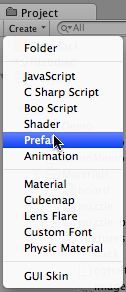
Now if you use the prefab object to populate the stage you end up with multiple instance of the same base object. Are all you objects too big? resize one on the stage and say “apply to prefab” it will ripple the change back to the base class and then back out to all the instances.
Each object can still have its own configuration. e.g. drop a rotation script on the prefab, they will all rotate on stage/scene.
However if you expose parameters on that script you can set the rotation speed individually for each of those objects. i.e. overide the defaults.
The visual nature of the objects and the scene and the visual application of changes is a great teaching tool for those people not yet quite grokking the whole class and instance thing in regular code.
It would be nice if when creating a new object in the scene you were prompted to make it a prefab and 9 times out of 10 that’s what you want to do, but thats a minor thing.
A powerful part of the gaming recipe – Graphics
This video is doing the rounds and was used at the FCVW conference showing the powerful rendering capabilities of Cryengine 2, Unity3d and Unreal engines.
I think of all the elements in this the live linking to Maya showing the boned and rigged wireframe being manipulated at the start starts to open up peoples appreciation of what goes into these engines.
Also with the fantastic level of graphic quality you need a fantastic level of modelling and texturing. Awesome lighting still needs to be placed on set in the right place. All this is also before you get to the layer of gameplay, the way that a multiplayer environment might synchronise its data. The rules of any game, the testing of the entire product, the sound design, music etc etc.
A graphics and physics middleware selection is important, and these render tests really show the potential, but there is a lot more.
Having said that though lots of the rest is more standard software engineering and IT architecture. It has to blend with the rich visuals of the user experience. Many techies have traditionally not been interested in the front end, its too obvious when it goes slightly wrong I think 🙂
Anyway enjoy the video, think under the graphics and see what amazing creations can be put together for work and play.
Develop Brighton 2011 – featuring Virtual Worlds
I just got the great news that my application to present at the Evolve portion of this years Develop conference has been accepted. It will of course be an elective session. Having attended Develop the last couple of years, and really enjoyed the sessions I felt that the virtual world industry and the crossover into social media was missing. So this year I thought I would throw my hat in the ring and do a version of washing away cave paintings.

Evolve is a part of the conference on day 1 that is about emerging trends and tech. Michael Acton Smith of Moshi is keynoting the day too 🙂
I submitted this as my talk.
EVOLVE: So You Think Virtual Worlds Aren’t Important?
Session Details
User generated virtual worlds may seem a sideshow. Open source development is making inroads, with Opensim, into fully user generated environments hosted anywhere run by anyone. These are used for entertainment and in training medical staff or school education.
They are an innovative platform for the next wave of designers and programmers. We have shown, on the kids ITV show The Cool Stuff Collective, these virtual worlds are growing to be a distribution platform for goods that will not remain solely as digital properties. Virtual things are getting real. Come and pay attention to virtual worlds and the future.
Wish me luck and maybe see you there (early bird registration finishes june 15th )
My takeaway from FCVW2011
FCVW11 was a great conference for several reasons. The first was to be able to meet and talk with the IEEE VW standards group that is forming. We got to discuss at length the Sep 20/21st summit that is planned for L.A. this year. As a group we have a number of VW old hands and gurus and I am honoured to be in the loop with them all.
Another reason was to meet quite a few people in the industry that we have only met briefly physically or it was a very long time ago. That made this conference a bit of a homecoming.
The third reason was hearing so many presentations and panels by practioners, educators, military, government and alike who are busy doing some really influential and great work.
To hear about the Post Traumatic Stress Disorder helper experiences, or Bill May’s US to Cairo project showed real, tangible and positive uses of virtual worlds.
It was less comfortable to hear about the military uses, but it shows the power of training and simulation in something that in the end could save lives.
Ren Reynolds did point out when on our panel that we were having questions asked about identity and behaviour in virtual worlds, e.g. what about furries. He bravely pointed out (given we were at the National Defence University) that using virtual worlds and games to work out how to actually kill people more effectively was far more offensive than any roleplay elements or socially awkward situations.
However, the military uses can be separated out into organisational analysis or education that applies to more regular applications.
Two of the keynotes that stood out for me, mainly because of the validation or handy terminology they provided were.
MK Haley – Faculty and Associate Executive Producer at the Entertainment Technology Center, Carnegie Mellon University
and
Dr Chris Dede -Timothy E. Wirth Professor in Learning Technologies, Technology, Innovation, and Education Program, Harvard University
MK was a powerful and sparky presentation that talked about looking at things differently, how creative thinking is possible by everyone but that it is often beaten out of us.
Dr Dede talked (and showed) some kids education environments that were around explore an eco system at a lake. On the surface it was a lake, trees and some overlays, but there were some innovative ideas that he helpfully referred to as “magic”. This magic is where you move from a straight simulation and help with pointers or tools that would not otherwise exist. The first was a submarine that scales you down to microscopic levels to explore the environment. The other was the ability to virtually geotag a single atom and then a HUD that tells you were it is over time as it is absorbed or moved around the environment. The “magic” layers can conflict with the “real” layers but are essential in the balance of immersive environment use. Otherwise there is little extra that the place give you. As a true educator and very well respected he, and his team, are doing the work to compare the virtual experiences with traditional teaching. Though he was very clear that if you compare something to nothing it will always be better. Of it you compare something the the worst example then you are not really helping. So he is making sure in helping explore how kids develop their reasoning.
Botgirl created some great cartoons to sum up each panel, this is the Dr Chris Dede one

So there are even more people doing real work with the technology and the socially changing impacts of virtual worlds and related tech. It is not dead, it is not all Second Life (in fact increasingly it appears to not be Second Life for some very good reasons). However it is well on its way, and it is helping people. Kids are learning more, patients are being treated better, entertainment is more engaging. Standards and exemplars are being re-enforced and more new people are becoming evangelists. The previous generation and generations of activists in the field are also not going away but supporting everyone else too.
So I am really happy to see this become so normal, yet keen that we push it further and make it extraordinary again.
Well done all 🙂
In Washington DC for FCVW 2011
Right now I am in the US, in Washinton for the Federal Consortium of Virtual worlds as part of a delegation from e426.org and the IEEE to discuss virtual environment standards and eco systems. This is all very cool and forward thinking as twe are not just talking about file formats but about human experience.
Rather pleasingly though Dave Taylor has a poster session here and did a demo yesterday of the Missive Project. Around major incident simulations. This is a project very dear to my heart as various aspects of it are things that I built as Feeding Edge Ltd.
It is worth reading his post(er) and I am sure I will talk to a few more people at the conference about it.
Lots of the environments send and receive data form various sources. A web menu drives options, a remote virtual patient in a scenario model responds. I do all the brokering and message aggregation and interpretation in the middle. Old habits die hard, this was SL/opensim middleware.
It is great to catch up with friends old and new from the industry but if you need an ROI on virtual worlds (do you want to sit like this for 8 hours 🙂 )
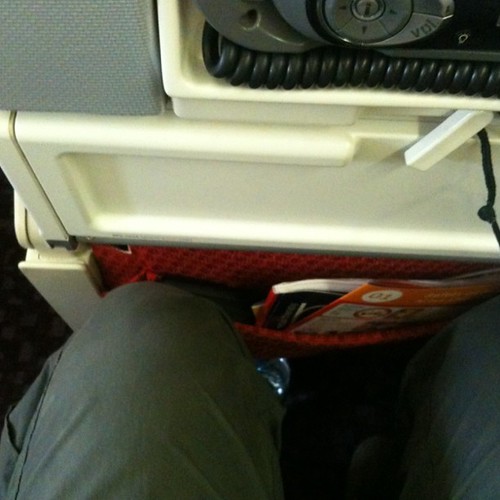
Also I discovered on the flight over just how pitiful the 3DS battery life is, no wi-fi on and it only lasted about 3.5 hours of playing ghost recon! Not good. Though it did make me watch The Social Network on the seat back TV instead, which was much better than I though it would be.
Anyway, off to the conference.
Claiming back 3D – b.Tween3D
@andypiper pinged me and said was I aware of this upcoming event. I was not but I know if I had of been paying attention I would have been straight on the case for this.
http://btween3d.co.uk/ is an upcoming event, the content of which is being formed right now that is aiming to reclaim 3D and push forward the sort of experiences that we can grow from various combinations of ideas and technologies. Not just sitting with specs on in the cinema.
It is something that I think we need to do, which is why I often finish my talks with the picture of an ecosystem of content and inputs/outputs and transformations.
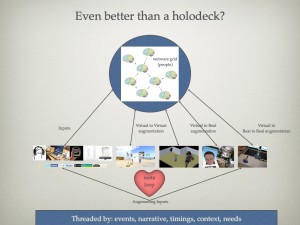
Virtual worlds and data augmenting physical worlds, augmenting other virtual worlds and also 3d printed goods from environments affecting the interaction in a physical environment which in turn alters a virtual or augmented environment. Its a loop. It challenges where the boundaries of “3d” or immersion are. It stops people thinking that everything is in one place or done one way. It also points the way to a vast set of new uses and interactions and businesses to grow.
As an example, take Alice Taylor / @wonderlandblog and her startup Makieworld. Here Alice is creating a business to allow people to build their toys and 3d print them out. Now what happens when that toy is then part of another digital capture experience, e.g. being held whilst an xbox kinect mocaps the player. The previously digital to physical has become digital again.
It is a fascinating loop, with no particular end point or start point. It has had me pondering it for some time, and each pitch I give it becomes more obvious to me this is where we are heading. It’s not just AR layers, not just games, not just virtual worlds for meetings, not just social media, not just location based services, not just 3 visualization, not just printing a 3d model. It is all of those, with stories and meaning intertwined where we need it as humans to get benefit and pleasure.
Cool Stuff at INTECH – The final show
So there we are, the last show of series 2 of The Cool Stuff Collective is airing this week. It is hard to believe that this time last year I had only done a few TV interviews, and now I have 26 shows under my belt!
For this final show it was a big gadget adventure to the wonderful hand on science centre INTECH near Winchester. I know this place quite well as I have visited a few times both as a parent and also in a professional capacity. I was lucky enough to go and see the Planetarium as it was being built and also to go and talk to the board about virtual worlds and do my more usual Metaverse Evangelism.
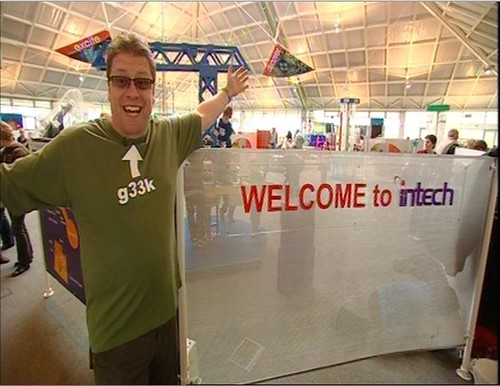
For the piece we spent all afternoon dashing from exhibit to exhibit (There are at least 100!). It was during a half term break so the place was buzzing, and of course bringing a camera crew in tends to attract a little attention. We also filmed after closing too though. Everyone there was very helpful and they do a great job as they build most of the exhibits and experiments and keep the place in tip top working order.
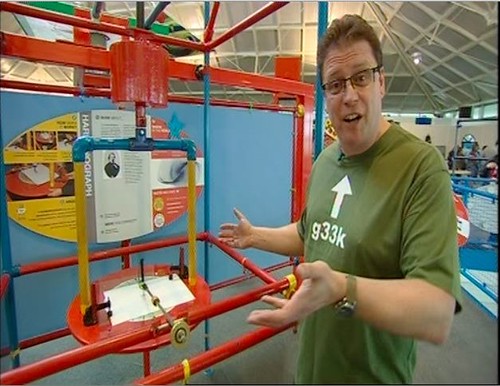
We did film quite a lot of the Reactable, though much of it must have hit the cutting room digital waste basket in order to keep the piece to time. Still its a great gadget if you want to play with one go to INTECH!
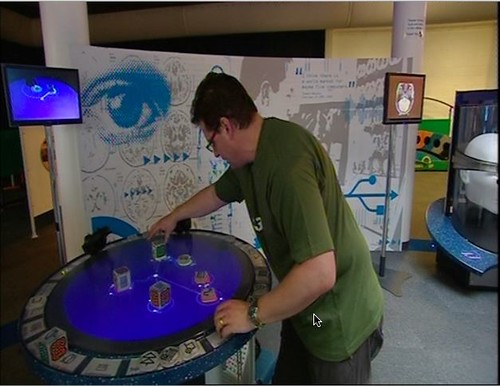
We also wanted to make sure we got the aforementioned planetarium in to. We left this until last to not get in the way of the families that had come to see the presentations.
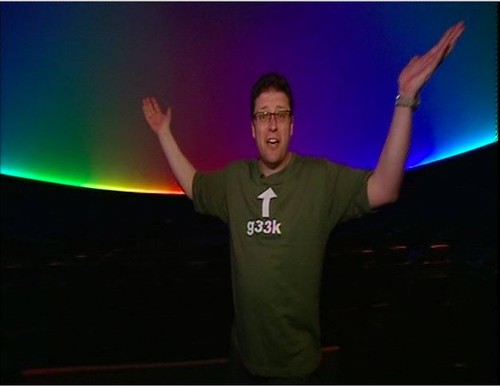
As this was the last show there end gag was that I was to be packed up and put into storage until next series as Sy Thomas looks on in disbelief. This is probably what a few people out there would like to see more of 😉
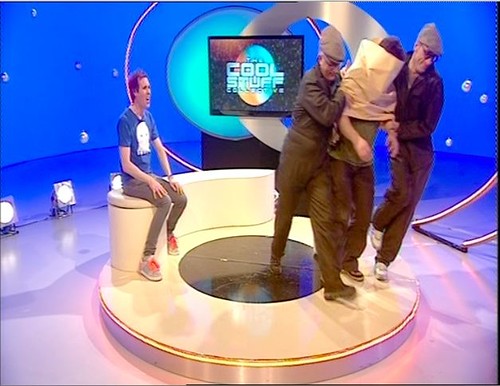
I hope its a nice small storage facility and not a giant Area 51 style warehouse as in Indiana Jones, or I may not be found ever again.
Anyway, that a wrap x 2, and it can still be found on ITV player for a few weeks in the UK too 🙂
The Cool Stuff Collective is back in the autumn for series 3 🙂
